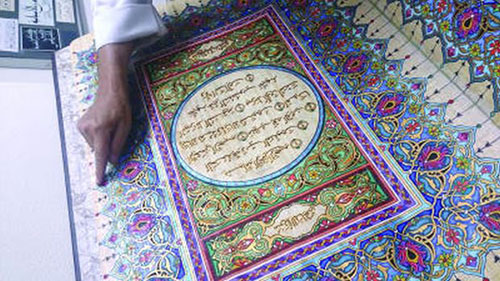Egyptian calligrapher completes a unique Quran
The copy took over four years to complete, with purely traditional methods and materials.
«If I have the chance to write another version of the Holy Quran, I would accomplish it in half the time,» says Egyptian calligrapher Taher Emara on the subject of his completion of the unique Al-Faisal version of the Holy Quran. The text was entirely handwritten on papyrus with water-based ink, free of chemicals, in the hope that this version will remain safe and last for thousands of years.
In an interview with Asharq Al-Awsat, Emara indicated that the Al-Faisal version is unique because it represents painstaking craftsmanship, with all of the writing, drawing, ornamentation, and gilding of the book done by hand on a single large papyrus measuring 3 feet (1 meter) by 2 feet (70 centimeters).
According to Emara, the new version took fifty months of continuous work. Of this period, one full year was consumed in completing the first few pages. He said, «I wrote it all with my handwriting. In the ornamentation, however, I was assisted by four art specialists who graduated from the Faculty of Art Education.»
The Al-Faisal version of the Holy Qu’ran was put on display in Medina some time ago, during a large gathering for the world’s most renowned calligraphers, where it was widely admired. Its final home will be the King Faisal Memorial Hall, after it was on display in a number of Islamic centers around the world.
Emara says that he sees himself as one of the world’s last highly experienced calligraphers still using quill pens and ink in his work. His skills have also found an outlet as an official calligrapher for Saudi Arabia’s currency, having worked on four of the designs for the Kingdom’s banknotes.
Emara’s engagement with the Saudi currency began with the Kingdom’s commemoration of the centenary of the founding of what became the Kingdom of Saudi Arabia, marking the entrance of the Kingdom’s founder, King Abdulaziz, into Riyadh. According to Emara, writing on coins is the most difficult of all because it is done in Thuluth Islamic calligraphy. His Thuluth handwriting also appeared on the 20 and 200 rial banknotes, and then on the new SAR 500 bills, as well as on the bills since the Custodian of the Two Holy Mosques King Abdullah Bin Abdulaziz assumed the throne.
 Egyptian calligrapher completes a unique Quran
Egyptian calligrapher completes a unique QuranSource: www.aawsat.net



